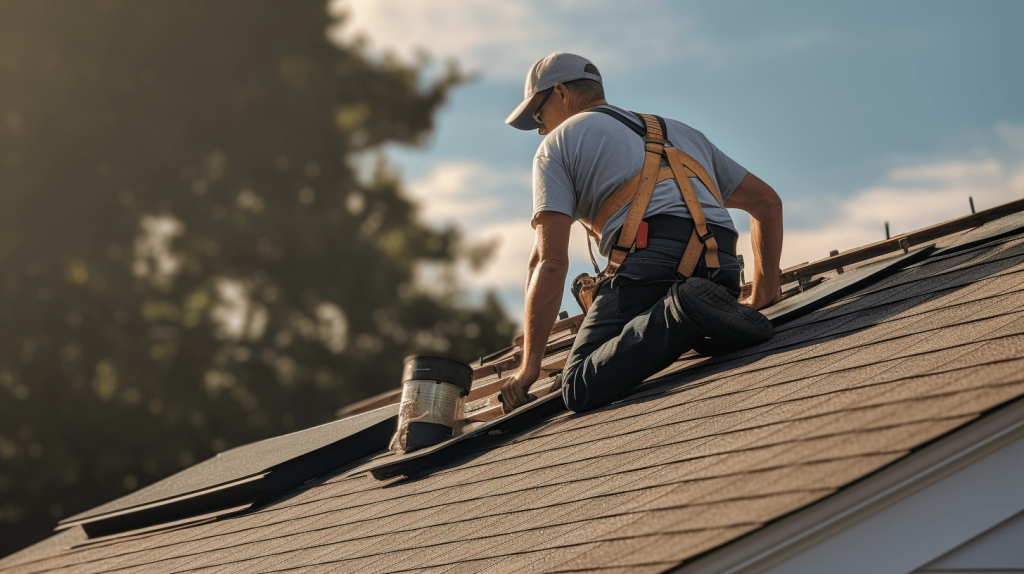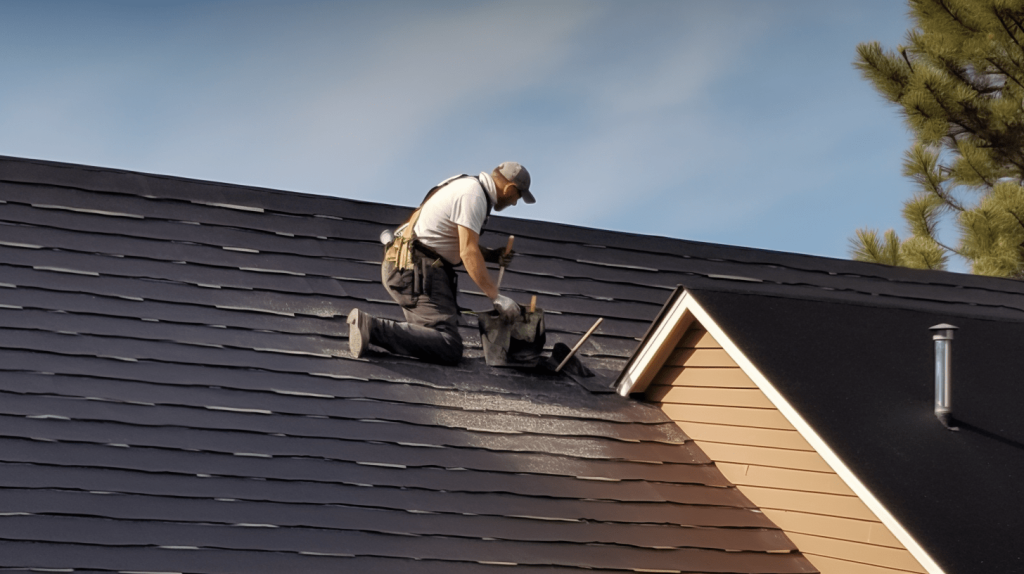
What is Roofing Felt Made Of?
This material is made from asphalt saturated paper or fiberglass mat that is then coated with asphalt adhesive and minerals. This creates a water resistant or waterproof membrane.
Asphalt saturated paper is made of cellulose fibers or wood pulp that is soaked in asphalt. This makes it water resistant.
Fiberglass mat provides a stronger, more durable felt base. The glass fibers are covered in asphalt and minerals.
The asphalt coating provides waterproofing while the minerals reflect sunlight and add fire resistance.
Types of Roofing Felt used
There are several different types to choose from:
– #15 lb felt – The most affordable and commonly used option. Provides basic water resistance.
– #30 lb felt – Heavier and more durable than #15 felt. Offers enhanced waterproofing.
– Synthetic underlayment – Made from recycled plastic, fibers, rubber, or wood pulp. Eco-friendly.
– Self-adhering underlayment – Coated with a peel and stick adhesive to simplify installation.
Roofing Felt Grades
Based on its material strength and durability:
– #15 perforated – The basic venting grade of felt with holes for airflow.
– #15 unperforated – The standard water resistant grade. Non-perforated.
– #30 perforated – High temperature resistant with enhanced ventilation.
– #30 unperforated – The highest strength and most durable commercial grade.
Functions of Roofing Felt
There are several important functions that roofing felt provides:
– Moisture protection – Creates a water resistant barrier against rain and snow.
– Leak prevention – Seals around roofing nails, fasteners, and joints.
– Ventilation – Perforated felt allows water vapor to escape from the attic.
– Fire resistance – Meets building code standards for fire safety.
Is Roofing Felt Underlayment Waterproof? 15 lb vs 30 lb
The answer depends on the type and grade of felt. Higher grades like #30 are more waterproof than #15. Synthetic underlayments and self-adhering membranes offer the best waterproofing. But even #15 felt provides essential leak protection.

The Difference Between Synthetic Roofing Felt And Tar Paper
Traditional roofing felt is made from asphalt coated paper (tar paper). Synthetic underlayments are made from recycled plastics, rubber, wood pulp or other fibers. Synthetics are more tear resistant and environmentally friendly. Synthetics have water resistance built in.
Why Use Roofing Felt Paper?
Felt paper provides a protective barrier against moisture and leaks. It also allows attic ventilation, meets fire codes, and prevents wind damage. Roofing without felt risks serious leaks, mold growth, and roof failure over time. Felt is a small upfront investment that pays off in roof longevity.
What is the Minimum Underlayment for Asphalt Shingles?
Building codes require at least one layer of #15 felt under asphalt shingles. In cold climates, #30 felt is recommended. Self-adhering underlayment is also acceptable. Two layers may be installed for enhanced durability. Always check local codes for the minimum roofing felt requirements.
Get Your Asphalt Roofing Felt Installed with American Roofing Company
Trust an industry leader like American Roofing Company for professional asphalt felt installation. Our roofers understand proper underlayment techniques and will ensure a long-lasting, leak-free roof. We work with the highest quality felt products. Contact us today for a free estimate!
Can You Install Shingles Over Felt that Has Frost or Snow?
It’s not recommended to install shingles over felt covered in frost or snow. The moisture can compromise the adhesive backing. Wait for the felt to fully thaw and dry out before shingle installation. Use caution and remove anyfelt damaged by freezing. Let our experts assess your roof’s readiness for install.

What is the Minimum Roof Underlayment for Asphalt Shingles?
The International Residential Code requires at least one layer of #15 felt beneath asphalt shingles. In cold climates, upgrade to a #30 felt or synthetic underlayment for enhanced durability.Self-adhering membranes are also acceptable. Some areas call for double layer felt. Verify your local codes.
Roof Felting and Waterproof Membranes
Roofing felt provides a water resistant barrier against leaks, while membranes create an impermeable seal. Combining both creates a redundant system for the ultimate in waterproofing. Use peel-and-stick membranes at valleys, ridges and protrusions, covered by felt over the roof deck. Get professional guidance on integrating felts and membranes.
Do You Nail or Staple Roofing Felt?
Roofing felt is installed using large-headed nails or staples. Nails provide the most secure fastening. Staples are quicker but can pull out easier. Use 1″ nails or 1/2″ staples. Check that fasteners penetrate the roof deck. Space them correctly for proper felt attachment per code. Improper fastening can lead to blow-offs.
Ensuring the Longevity of Your New Roof Repair
Quality underlayment is key to roof longevity. Use the right grade and type of felt or synthetic underlayment. Fasten it correctly with nails or staples. Install flashings and membranes at vulnerable areas. Hire professional roofers who understand proper underlayment techniques. And don’t forget regular maintenance and inspections!
The Purpose of Roofing Felt – Is Roofing Felt Necessary?
Roofing felt is a critical component. It resists moisture, prevents leaks, allows ventilation, meets fire codes, and provides a durable base layer. While felt increases labor and material costs, it protects roof integrity. No serious roofer would install shingles without underlayment. Don’t cut corners – proper felt installation will pay dividends for years to come.
Conclusion
Synthetic roofing felts made from recycled rubber and plastic provide enhanced durability over traditional asphalt-saturated paper. These advanced synthetic materials resist tearing and outperform felt for long-lasting leak protection.
Roofing tar paper is a common asphalt-coated felt that creates a water barrier beneath shingles, helping shed rain and moisture. This traditional roofing paper gets its name from the black, tar-like asphalt used to saturate the felt.
There are many types of roof systems like shingles, metal, tile, and flat roofs that require a protective base layer to meet code. Roofing felt installed beneath the top layer provides critical leak protection.
Roll roofing is an affordable asphalt-coated fiber material that can function as a finished roof or secondary layer. As a base layer, roll roofing adds leak protection.
Proper installation of quality roofing materials is necessary to protect roof decking from moisture over time. A fitted base layer prevents leaks, ice dams, and helps new roofs meet code.
Hire residential roofing contractors with expertise in shingle selection, ventilation design, and base layers to get the best roof system. A professional roofer considers the whole roof, not just shingle layer.
Building codes require the use of roofing felt or synthetic materials to meet fire resistance and wind uplift standards. A fitted base is a must for code compliance.
Roofing felt weighs 15 to 30 pounds per 100 square feet and comes in rolls of 36” or 48” wide to cover roof decking. Heavier felt is more durable but also pricier.
Materials like roofing felt or synthetics provide a leak barrier between shingles and decking as part of a roof system. This extra layer is the first line of defense.
Quality roofing felt installation requires proper alignment, attachment with nails/staples, and weatherproof seams. Hire professional roofers experienced in base layer application.
While not completely waterproof, roofing felt gives an important first layer of water resistance and drainage beneath shingles. Use membranes for true waterproofing.
